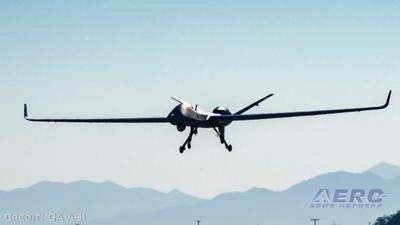Wed, Feb 07, 2024
Lean, Mean Testing Process Assists USAF & GA-ASI on Product Development
General Atomics has capped a series of test flights with the U.S. Air Force Special Operations Command to continue development on its Adaptive Airborne Enterprise concept.

A trio of notable demonstrations proved out a few elements of the project, with the first being a practical application of simultaneous control from a single control station. That test saw one team remotely command a triplet of MQ-9A aircraft from a single government-owned AFSOC RPA Control Suite. The ARCS system is shaping up to be the cornerstone of their MQ-9 test regimen, with an aim to one day use it to control the MQ-9A, the MQ-9B aircraft, and a family of small drones.
The second demo sent an MQ-9A on a firing test using an Altius 600. The 27-lb munition sports a loitering time of more than 4 hours, allowing for a good amount of standoff capability for a passing UAV. The third demo consisted of SATCOM launch & recovery operations, where a trio of MQ-0As were launched from portable control stations before being handed off to a single ARCS unit. Control was then handed off between the ARCS system and the original ground control suite, with the aircraft performing satellite-controlled landings afterwards.
“We have established a great partnership with AFSOC,” said David R. Alexander, president of GA-ASI. “We know our RPA will be a key building block for AFSOC to achieve its Adaptive Airborne Enterprise vision.”
General Atomics has continued to be a common sight around the AFSOC water cooler, thanks to its supportive attitude and convenient product portfolio. The brand has used the MQ-9B to forego some of the typical bureaucracy involved in acquiring developmental aircraft, allowing AFSOC to prototype quicker and more efficiently. That works for both sides, overall - the Air Force gets a leaner, more custom-tailored product and General Atomics gets solid development data as it builds products that warfighters actually want.
“These demonstrations were what we needed to really start to make A2E a reality,” said AFSOC Colonel Trey Olman. “This was the first time we were able to demonstrate control of multiple RPAs from a single workstation, which is important in reducing manpower requirements.”
More News
Mid-Continent Instruments and Avionics and True Blue Power ANN's NBAA 2025 Coverage... Visit Them At Booth #3436 101 Aviation Nears STC Approval for Lithium Battery Upgrade on Gulf>[...]
Hertz The standard radio equivalent of frequency in cycles per second of an electromagnetic wave. Kilohertz (kHz) is a frequency of one thousand cycles per second. Megahertz (MHz) >[...]
“NATCA does not endorse, support, or condone any federal employees participating in or endorsing a coordinated activity that negatively affects the capacity of the NAS, or an>[...]
Aero Linx: European Association for Aviation Psychology (EAAP) Since 1956 the European Association for Aviation Psychology (EAAP) provides a forum for professionals working in the >[...]
Aircraft Experienced A Total Loss Of Engine Power During A Go-Around Attempt And Then Impacted A Soybean Field On September 13, 2025, at 1625 eastern daylight time, a Pegasus Quant>[...]
 True Blue Power and Mid-Continent Instruments and Avionics Power NBAA25 Coverage
True Blue Power and Mid-Continent Instruments and Avionics Power NBAA25 Coverage ANN's Daily Aero-Term (10.11.25): Hertz
ANN's Daily Aero-Term (10.11.25): Hertz Aero-News: Quote of the Day (10.11.25)
Aero-News: Quote of the Day (10.11.25) ANN's Daily Aero-Linx (10.11.25)
ANN's Daily Aero-Linx (10.11.25) NTSB Prelim: Pegasus Quantum 15
NTSB Prelim: Pegasus Quantum 15



